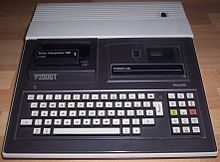Philips P2000
 Philips P2000T | |
| Manufacturer | Philips Austria |
|---|---|
| Type | Home computer |
| Release date | March 1980[1] |
| Introductory price | 3000 guilders (equivalent to 2725 EUR in 2015) |
| Operating system | 4 KB ROM containing BASIC and JWSDOS, CP/M with extra card[1] + 12 KB Cartridge |
| CPU | Zilog Z80 @ 2.5 MHz |
| Memory | 16 KB RAM, expandable to 48 KB [1] |
| Display | Text mode 40 × 25, 7 Colors |
| Graphics | Mullard SAA5050 Teletext chip |
| Sound | Beeper, 1 channel |
| Connectivity | 2 cartridge slots T version: TV aerial, RGB, Serial M version: Monochrome composite video, FDD interface, Serial |
The Philips P2000T[2][3][4] home computer was Philips' first real entry in the home computer market in 1980,[5] after the Philips Videopac G7000 game system[6] (better known in North America as the Magnavox Odyssey2) which they already sold to compete with the Atari 2600 and similar game systems. There was also a P2000M[2][5][7][4] version with an additional 80-column text card for use with a monochrome monitor. This version shipped with a monitor cabinet also housing a dual 5¼-inch floppy disk drive.[1] The P2000C version, introduced in 1982, was portable.[5][4][8]
The P2000 systems can be emulated with the MESS software, and since 2015 they are part of MAME.[1] Other emulators also exist.[9]
P2000T
[edit]The P2000T was a Z80-based home computer that used a Mullard SAA5050 teletext display chip to produce the video picture and a small Mini-Cassette recorder for 42 kilobytes of mass storage capacity.[1][5][10][11] The Mini-Cassette was treated as a floppy drive from the user's perspective, using the automatic search for a program (CLOAD command) or free space (CSAVE). A command to display the directory of the cassette was also implemented.[1]
Philips used components they already produced for other markets (television sets and dictation machines) to quickly design a small computer system. It was partially designed by professor Dieter Hammer. Philips used the ROM cartridge system from their Videopac G7000 game system. One of these cartridges contained Microsoft BASIC.[12]
Although the teletext video chip permitted a quick entry into the home computer market, it was a major weakness of the P2000T. Using the teletext standard allowed it to support eight colors and rudimentary semigraphics, but unlike later entries in the home computer market which also supported a teletext display (such as the BBC Micro and Oric Atmos), the P2000T did not also have a high resolution mode. Consequently few games were developed for the P2000T.[13]
As a result, the P2000T had only limited success, and Philips later replaced it with their MSX machines. The machine did gain popularity in Netherlands, especially in the areas of science, education,[3] and data communications (videotex).
Initially, in 1981, the computer cost 3000 guilders (€2725 in 2015's money). In 1984 the price was lowered to 1200 guilders (€967 in 2015's money).[3][14]
P2000M
[edit]The P2000M incorporated two 5¼-inch floppy disk drives,[7] besides a built-in monochrome screen. It could run CP/M or Microsoft BASIC applications, depending on the cartridge used. It was incompatible with the P2000T due to the way it handled display of special characters (color, "graphics mode"), which made most P2000T games unplayable.
References
[edit]- ^ a b c d e f g "TnTRBOX PRESENTS THE PHILIPS P2000". TnTRBOX. Retrieved 2022-12-24.
- ^ a b "P2000 T/M Philips". www.old-computers.com. Retrieved 2022-12-24.
- ^ a b c Klooster, Erik. "Philips P2000 - a solid, dutch home computer". History of Home and Game Computers. Retrieved 2022-12-24.
- ^ a b c "Philips Z80 Microcomputers". Kees's Computer Home. Retrieved 2022-12-24.
- ^ a b c d "Philips P2000T". Silicium. Retrieved 2022-12-24.
- ^ Dekker, Bart (2022-09-11). "Philips P2000T". Retrogamer. Retrieved 2022-12-24.
- ^ a b "Philips P2000M". HomeComputerMuseum (in Dutch). Retrieved 2022-12-24.
- ^ "Philips". Computer-Archiv. 2004. Retrieved 2022-12-24.
- ^ de Kogel, Marcel (2001). "M2000 distribution site". Marcel de Kogel's Homepage. Retrieved 2022-12-24.
- ^ Pernau, Andreas. "Philips P2000T". Homepage von Andreas Pernau. Retrieved 2022-12-24.
- ^ Kohnke, Wolfgang (2001). "P2000". Wolfgang Kohnke Industriemeister Druck. Retrieved 2022-12-24.
- ^ Gutmeier, Thomas. "Philips P2000T". 8Bit-Homecomputermuseum Retrocomputer, Heimcomputer und Videospiele der 80er. Retrieved 2022-12-24.
- ^ "Listing of all Philips P2000T games". The Video Games Museum. Retrieved 2022-12-24.
- ^ "Historische waarde van de gulden". 20 April 2023. iisg.nl. Accessed 2 December 2016.
